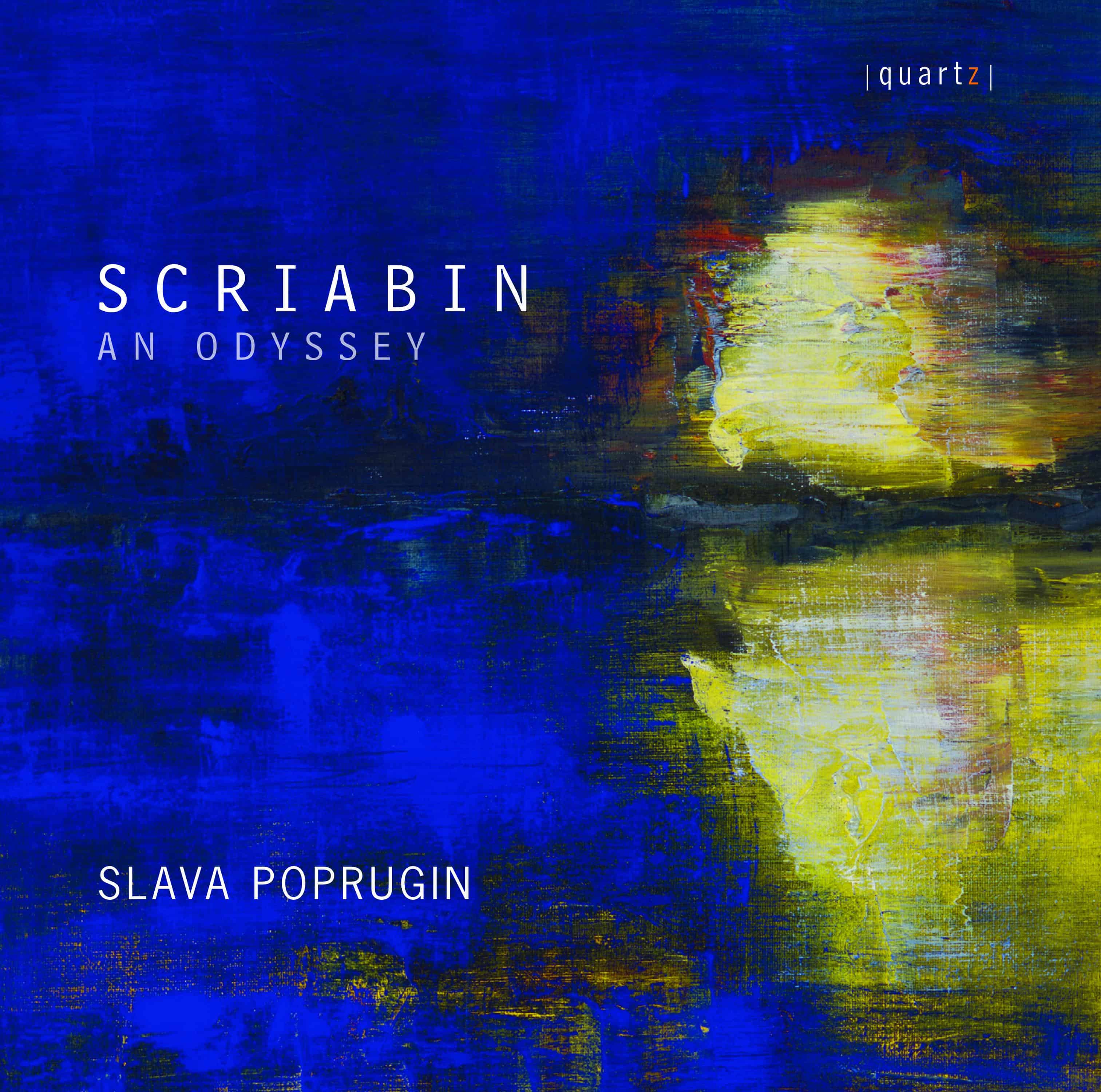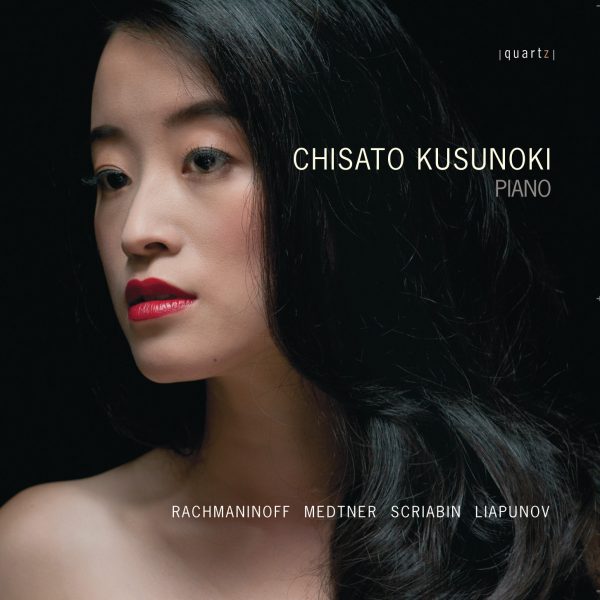Scriabin: An Odyssey
Price range: £7.99 through £16.99
With this program, Slava Poprugin draws together pieces that are connected through the realisation of similar ideas in Scriabin’s different stylistic periods. For example, the pathetic, rebellious line is drawn in the Etude Op.8, No.12, Prelude Op.11, No.14, Prelude Op.27, No.1, Poeme Op.32, No.2, Preludes Op.48, Nos.1&4 and going to Op.74. The theme of erotic sensibility engulfs pieces from Op.1 and culminates in Op.57. Scriabin’s bestiary is represented by the pieces Op.22, No.3, Op.52, No.2, Op.63, No.2: here, light butterfly-like shapes transform into what Sabaneev calls in his memoir of Scriabin “some small winged creature, half-woman, half-insect, but necessarily female; it is somewhat spiky and twisted, and a little disjointed.”
About This Recording
Hello, my name is Slava Poprugin. I’m not a pianist. I have been playing piano for over 40 years, I give concerts, I teach at the Hague Royal Conservatory, I record musicians in my studio in the Netherlands and I can’t call myself a pianist. I identify as a “musician”.
For this, I owe thanks to my teachers that I’d like to mention here – Marina Ternovskaya and Larisa Tokareva in my home-city of Khabarovsk and Alexander Alexandrov at the Moscow Gnessin Academy. As well I would like to extend my thanks to my colleagues at the time when I taught at the Moscow Tchaikovsky Conservatory – Natalia Gutman and Alexey Lubimov, who became my stage partners for many years. During that same period, my passion for the art of recording brought on a collaboration with the sound- engineer Alexander Krasheninnikov whom I consider to be my mentor in this field.
I have certainly not had a straight or simple professional path. However I believe that, having avoided the “mainstream”, or any sort of “stream”, really, I have gained the freedom to be ultimately sincere in all the things I’m doing.
Already during my childhood, I became absorbed in Scriabin’s universe and fascinated with the idea of embracing the transformation of his style in one concert. With this program, I draw together pieces that are connected through the realisation of similar ideas in Scriabin’s different stylistic periods. For example, the pathetic, rebellious line is drawn in the Etude Op.8, No.12, Prelude Op.11,
No.14, Prelude Op.27, No.1, Poeme Op.32, No.2, Preludes Op.48, Nos.1&4 and going to Op.74. The theme of erotic sensibility engulfs pieces from Op.1 and culminates in Op.57. Scriabin’s bestiary is represented by the pieces Op.22, No.3, Op.52, No.2, Op.63, No.2: here, light butterfly-like shapes transform into what Sabaneev calls in his memoir of Scriabin “some small winged creature, half- woman, half-insect, but necessarily female; it is somewhat spiky and twisted, and a little disjointed.”
Op.74 holds a special place in this programme. It is the last opus Scriabin completed, and it sounds as if it was an abstract of his Mysterium – from the bells tolling in the first movement, to the universal collapse in the last one.
This CD was recorded in 2017 in my own Steppenwolf studio, on the 1897 Bechstein concert grand piano from the Andriessen Collection Haarlem. Being both the performer and the sound engineer of this recording, I have tried my best to preserve all the finest nuances of this wonderfully and lovingly restored piano.
—Slava Poprugin (transl. by Elizaveta Miller)
Praise of symmetry
The orderliness of the execution on the programme on this CD may at first seem a little too rational, analytic, and even cold. The listener might get the impression that Poprugin performs both early and late works of Scriabin in the same manner, as if they were links belonging to the same chain, or parts of a single meta-opus. This is true, and it corresponds to the internal logic of Scriabin’s compositional technique.
Before all things, Scriabin asserts order. His famous élan represents the ultimate quality of this order – an unstable equilibrium. The listener perceives it directly, through rhythm and texture, and expects unwittingly the performer to be equally “fiery”, much in the manner of Sofronitsky, the model Scriabinist. To confuse what one hears on the surface with the internal logic of form is a standard consumer’s delusion. The same goes for the relation between decor and the supporting construction in architecture. Thus, the Feuillet d’album (track 29) pretends to be a caprice, a carelessly thrown shawl, but has, in fact, a precise mathematical structure.
Scriabin’s equilibrium remains unstable only in opposition to an external, objective stability – and for Scriabin it is the categorical imperative of the tonic, until the moment it ceases to exist.
This “moment”, to be more precise, is of course a significant stage in the evolution of Scriabin’s style, approximately from Opp.40 to 50, when he stops assigning keys to his works (tracks 17–26). This calls for a more technical description.
A triad – two superimposed thirds – is fully consonant. When we add another third on top, we get a 7th chord, which has a dissonant interval, the seventh. The more
thirds we add, the more dissonances we introduce, and the more tonal function is weakened. For example, a dominant 9th chord contains the II5/3 that belongs to the subdominant group, the dominant 11th chord contains the subdominant itself (the IV5/3), and the chord of V13 is made of all the seven tones of the diatonic scale (6 thirds superimposed).
This logic is reversed with quartal chords that Scriabin favours in his later works. A chord made of two consecutive fourths is fully dissonant. The addition of a third 4th yields the consonant interval of 10th (a third over an octave), and so on. A chord of 5 superimposed fourths is consonant enough to become a point of rest, an arrival. The ear perceives it as syntactically stable, if not as tonal.
Chopin’s C major V7th chord with an added 6th contains the tones G-F-B-E. Out of context it can be considered as a quartal chord. Add a C# between G and F, and you almost get the “Mystic chord”, with a missing A over E. This chord appears in the close of Désir, Op.57 (track 27) that this chord remains (finally!) unresolved and receives a stable harmonic status.
(In fact, it is the discovery of his own “Tristan chord”, that is, an individual harmony- signature with enormous symbolic and syntactic weight, yet unstable in terms of classical tonality.)
Convention has it that Chopin was a role-model for young Scriabin, in genre and in harmony. Scriabin’s treatment of both would become gradually more complex, in a typical fin-de-siècle manner, until this complexity would have destroyed the very foundations of tonal gravity.
It is in fact the opposite. Scriabin always sought simplicity and order, but an order in the physical sense of the term. We can use the metaphor of the early universe, more ordered in the sense that it wasn’t composed of nuclear matter, but rather of different subnuclear particles and radiation.
To continue with this rudimentary analogy, matter in classical tonal music is composed of thirds: its chords are tertian. Harmonic gravitation is provided by the fourth (and its inversion, the fifth), and melodic gravitation is driven by the second. Classical tonality resembles the Standard Model, where fermions constitute matter and bosons are force carriers.
Tonality in the second half of 19th century is not just extended and weakened. It gradually lost the functional distinction of intervals altogether.
One can argue that, for Scriabin, it all started with the “Chopin Chord”. It opened the doors to structural transformations, wherefrom there was no turning back. The Prelude in F-sharp minor (track 20) is an instance of the Chopin Chord as a kind of “philosophical hammer”.
In the late pieces, in the absence of distant harmonic relations, the form collapses. The fourth doesn’t provide tonal gravity, but only chordal matter. What remains is moving from one vertical structure to the next. The melody itself is locked within these vertical progressions: non-chord tones do not exist anymore, and any note can change the harmonic structure, so it has to be introduced with extreme care. The melodic line loses in freedom but gains in symmetry. This becomes tangible in Masque (track 31).
At the same time, the syntax of his late works remains quite similar to the language of the earlier works. In the Romantic syntax, that Scriabin unconsciously uses as a model, musical ideas are set out as a series of developing microvariations. They can appear as modulating sequences, as in the E-minor Mazurka (track 2), or within a tonality, as in the iconic D-sharp minor Etude (track 3). The form itself can sometimes be structured as consecutive departures and returns to a main idea – as in the D Major Prelude (track 5). This ultimately leads to the late pieces revolving around an idée fixe, notably in Étrangeté (track 32).
The austerity of the interpretation on this CD appears, besides its graphical harmonic transparency and a quasi-statuesque sculpturing of melody, in a restricted, scarcely dosed use of metrical freedom.
This also calls for an explanation. Meter is a probabilistic distribution of events between beats. “Meaningful” events are more likely to happen on strong beats. However the very idea of “meaningfulness” of these events existed for Scriabin, for whom harmony possessed an ever-growing importance, only in the context of tonal hierarchy. Where tonal gravity is weakened, so is harmonic hierarchy of events, and therefore, meter. Along with a weakening meter, Scriabin questions the concept of tempo as an integral part of meter. In other words, tempo, as a system, concedes to speed.
The late opuses, for instance the Poème-Nocturne (track 30), preserve only the interplay of speed and density. Thus, the performer loses his freedom related to (and assumed by) the metrical structure. Poprugin plays the early pieces with an anticipation of the later rigorism and restraint. He underlines symmetrical structure and their variety, as opposed to the genre and romantic freedom. This is very unusual, but fully justified by the logic of Scriabin’s composition technique: transformations of harmony and texture, as deep as they were, did not affect the syntax of his musical speech. In fact, being grounded in these foundations allowed Scriabin to complete his radical transformation, while preserving his musical identity.
Boris Filanovsky (transl. by Elizaveta Miller)
Track Listing
- Waltz in F minor (1886) Op.1
- No.7 Mazurka in E minor
- No.4 Mazurka in E major
- No.12 Etude in D-sharp minor
- No.5 Prelude in D-major
- No.2 Prelude in A minor
- No.8 Prelude in F-sharp minor
- No.9 Prelude in E major
- No.12 Prelude in G-sharp minor
- No.13 Prelude in G-flat major
- No.14 Prelude in E-flat minor
- No.3 Prelude in B major
- No.1 Patetico in G minor 2’09
- No.2 Andante in B major 1’09
- No.1 Poème in F-sharp major 3’17
- No.2 Poème in D major 1’34
- No.1 Album Leaf in E-flat major
- No.2 Poème fantastique in C major
- No.3 Prelude in E-flat major
- No.1 Prelude in F-sharp major
- No.2 Prelude in C major
- No.3 Prelude in D-flat major
- No.4 Prelude in C major
- No.1 Poème in C major
- No.2 Enigma
- No.3 Poème languide in B major
- No.1 Désir
- No.2 Caresse dansée
- Album Leaf (1910) Op.58
- Poème-Nocturne (1912) Op.61
- No.1 Masque
- No.2 Étrangeté
- No.1 Douloureux déchirant
- No.2 Très lent, contemplatif
- No.3 Allegro drammatico
- No.4 Lent, vague, indécis
- No.5 Fier, belliqueux


